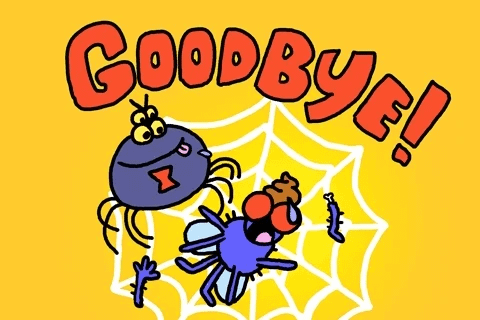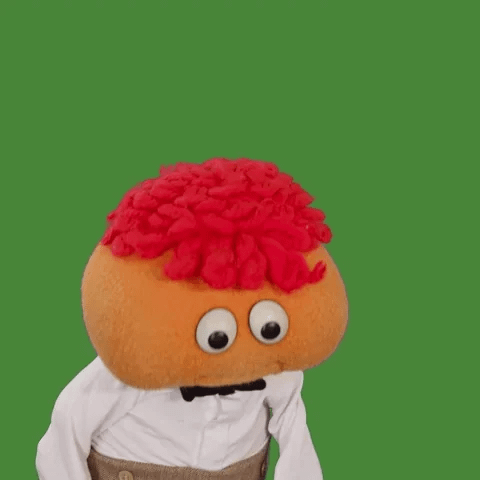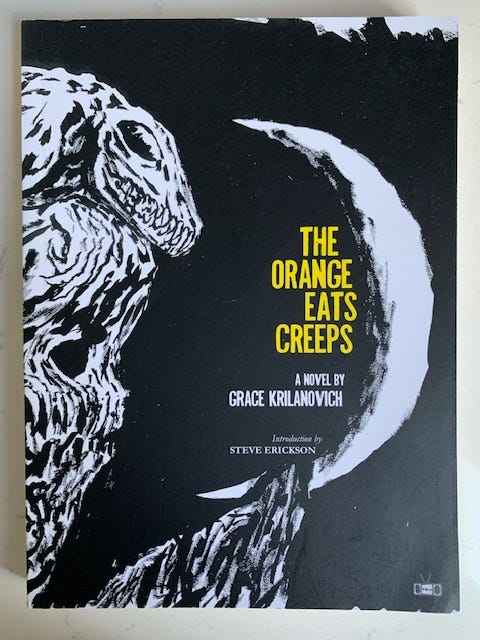'Time of the Flies' by Claudia Piñeiro
'Any other fumigator, anyone who doesn't understand this pain, would turn me in. I know that you understand me.'—Review #242

A man was causing a disturbance in the Brooklyn bookstore where I was killing time before the arepa place I wanted to go to opened for lunch. I couldn’t tell what the man and the staff were arguing about. I was toward the back of the store, but in order to keep an eye on things without looking like I was trying to keep an eye on things, I picked up the first book that caught my eye. It had a bright pink cover and a dead fly.
Here’s the book’s cover:

The man left without incident and peaceful browsing resumed. I looked more closely at the book, and flipped it over to read the description. ‘Fifteen years after killing her husband’s lover, Inés is released from prison and left to put together a new life. Her old friend Manca is out too, and together they’ve started a pest control and private investigation business, by women, for women. But Señora Bonar, one of her clients, wants Inés to do more than kill bugs: she wants her expertise, and her criminal past, to help her get revenge on someone.’ Murder? Bugs? Revenge? I was like:
But I didn’t buy Claudia Piñeiro’s ‘Time of the Flies’ that day in August; I was focused on eating a pernil arepa with a side of yuca fries. I also wasn’t familiar with Piñeiro’s work, but I have since learned that her previous novel, ‘Elena Knows,’ was short-listed for the 2022 International Booker Prize and was adapted into a film on Netflix. A few weeks later, a friend and I were walking through Greenwich Village, and we popped into a bookstore. I saw the pink cover and was like:
Charo is the name of the woman Inés shot and killed. Inés was so blinded by her pain over her husband’s infidelity that she didn’t realize her teenage daughter, Laura, was pregnant. When Laura gave birth, literally on the day of the murder, Inés was in handcuffs and never learned she was a grandmother. The two did not reconnect after Inés’s release, so she doesn’t know her daughter has launched a career as a school counselor, is married to a loving husband and has recently given birth to a second child, a son named Dante. Instead, Inés navigates the streets of Buenos Aires in her pest control-company van, and shares beers with Manca, who, when not following cheating husbands or doing other sleuthing, nurses a crush on Inés. But Inés is oblivious to that, too. One thing she does see, though, is a fly (apparently imaginary) that flutters in her eye and that she’s constantly shooing away. She sees it when she fumigates the home of Ms. Bonar, a big shot TV executive who is loaded—with money and very often also with pinot noir. Ms. Bonar reveals she knows who Inés is, and wants her help to obtain some pesticides to poison someone because she, too, is a jilted woman. Ms. Bonar hands Inés an envelope full of money and says there’s plenty more—she can name her price. Inés is like:

Now look, I’ve never committed a murder, and I’ve never been asked to be an accessory to one, so maybe I don’t know what I’m talking about, but I was surprised that Inés was so cool about Ms. Bonar’s wine-soaked proposition and that she considered it, knowing full well it could mean going back to prison. Alarm bells and red flags would have been going off for me. But Inés eventually accepts the offer because she learns that Manca, who has a lump in her breast, was only able to get an appointment with a doctor months down the road because she couldn’t afford a bribe. Inés figures she’ll use Ms. Bonar’s money to pay off the doctor and help her friend get treatment. She gets so focused on this that when it’s later revealed that her daughter, Laura, is a frequent guest at Ms. Bonar’s home, Inés still doesn’t see alarm bells or red flags, and doesn’t reconsider. She’s like:
Interspersed in the narrative are chapters where a Greek-style chorus speaks. Several disembodied voices weigh in on recent events in the story, and offer quotations from feminist and political writing, even providing footnotes. The story and the chorus build to a major plot twist, where it’s revealed that:
I have a lot of thoughts about the big twist. But instead of revealing it, I’ll talk about flies. Inés has an affinity for them. They’re insects that undergo a transition; at one point in their life they’re larva, and at another they can fly. Some people, like Inés, see beauty in this. Others see something to squash. The book asks us, what do you see:

This is a vital question. And the book shows that how we answer it is a matter of life and death. Even so, ‘Time of the Flies’ frustrated me. Piñeiro’s writing was engaging at times, but at others it felt repetitive. The chorus element was distracting; I found it did more to interrupt the flow of the story than to enhance it. And though it’s clear Piñeiro wanted her story to make a cultural and political point in a very specific way, at times it felt as if the characters were on rails headed only toward that destination. It robbed them of agency, and, as I mentioned above, sometimes it led to characters’ choices that made me scratch my head. They felt less like real people faced with problems to solve amid harrowing stakes. Because of that, it was hard to connect to their journeys, and the big reveal and the climax felt unearned. I really wanted to enjoy this book more. If you’ve read it, let’s discuss it in the comments.
An opening excerpt:
One hallway leads to another. Every once in a while, Inés hears someone call out to her, but she doesn’t turn around, she just raises a hand and then lowers it. She repeats this minimal gesture every time she hears her name, trying to be polite. She suspects that if she were to turn around she might break down and she doesn’t want the last image they have of her to be tearful. She wants them to remember her as a friendly woman. She said goodbye to Manca early that morning. Then they sat together at lunch but remained silent; everything they had to say had already been said in private, or didn’t need to be said, at least not for the moment. Because there are certain things Inés doesn’t even dare to let herself think, much less say out loud. Manca knows that certain things frighten her friend, and she doesn’t want to scare her.
Inés is led by a newer guard she hardly knows. She would’ve preferred to be escorted by one of the guards she spent so many years with there on the inside. Fifteen. The bag she carries on her shoulder weighs nothing since she gave away most of her few personal items. She feels like she’s about to be reborn—again; she was born for the first time when her mother delivered her; the second, when she killed Charo—Yours—and now she will be born for a third time as soon as they open the gates and she’s allowed to walk free. We’re born naked, so why take anything, she thought when they told her to pack her things, after she learned she was getting out. That’s what she thinks again now: we’re born naked.
My rating:
‘Time of the Flies’ (El Tiempo de las moscas) by Claudia Piñeiro was originally published by Alfaguara in 2022. It was translated from the Spanish by Frances Riddle and published by Charco Press in 2024. 358 pages. $16.69 at Bookshop.org.
What’s next:
Next week, we’ll have a discussion thread. The following week’s newsletter will feature:
Before you go:
ICYMI: Review #241
Read this: ‘Creativity Is in Its Corporate Sellout Era’ by Isabel Slone in her fantastic newsletter Freak Palace is a fascinating and important look at the corporatization of creativity. It makes me more than ever want to stick to being an obscure, random and weird book reviewer!
Read this, too: If you want to read a spooky book this Halloween season, but you’re like me and are a complete scaredy cat, our friend Ashley at Crooked Reads has some great advice for you.
Congrats! We’re excited to see that author Han Kang won the Nobel Prize in Literature. ‘The Vegetarian’ is one of the first books I reviewed in this newsletter. Random House posted on Instagram that Kang has a new book due out in January:
If you enjoyed this review:
Thanks for reading, and thanks especially to Donna for editing this newsletter!
Until next time,

MPV














I wrote 2 things in my review of ToF in July which I think I should say again! I said that I wouldn’t recommend ToF if you’ve never read Piñeiro before, that to enjoy it I think you need to distinctly understand how she approaches writing and telling stories. Bc this was your first Piñeiro, I can completely appreciate how it was not enjoyed by you. I would honestly direct you to ‘A Little Luck’ as a try again with her. I think you would enjoy that a lot more & could be a good opportunity to give Piñeiro another go! The ‘chorus’ in ToF is distinctly different for her - it’s nothing like her other books. So as someone who’s read all her work that’s been translated into English, I found it exciting to see her try a new form. But, that enjoyment obvs comes from previous knowledge and understanding of her work!
The second is that ToF is a sequel to another book, a book which details Ines crime & gives alot of back story. When I finished ToF and I had a lot of unanswered questions, and then learnt this was a sequel, it made a lot of sense! Charco did a loss not reprinting them together imo. All of this to say - I don’t think it’s her strongest but I think you should give her another chance!
Gifs are absolutely on point in this one. Thanks for the shout, friend!